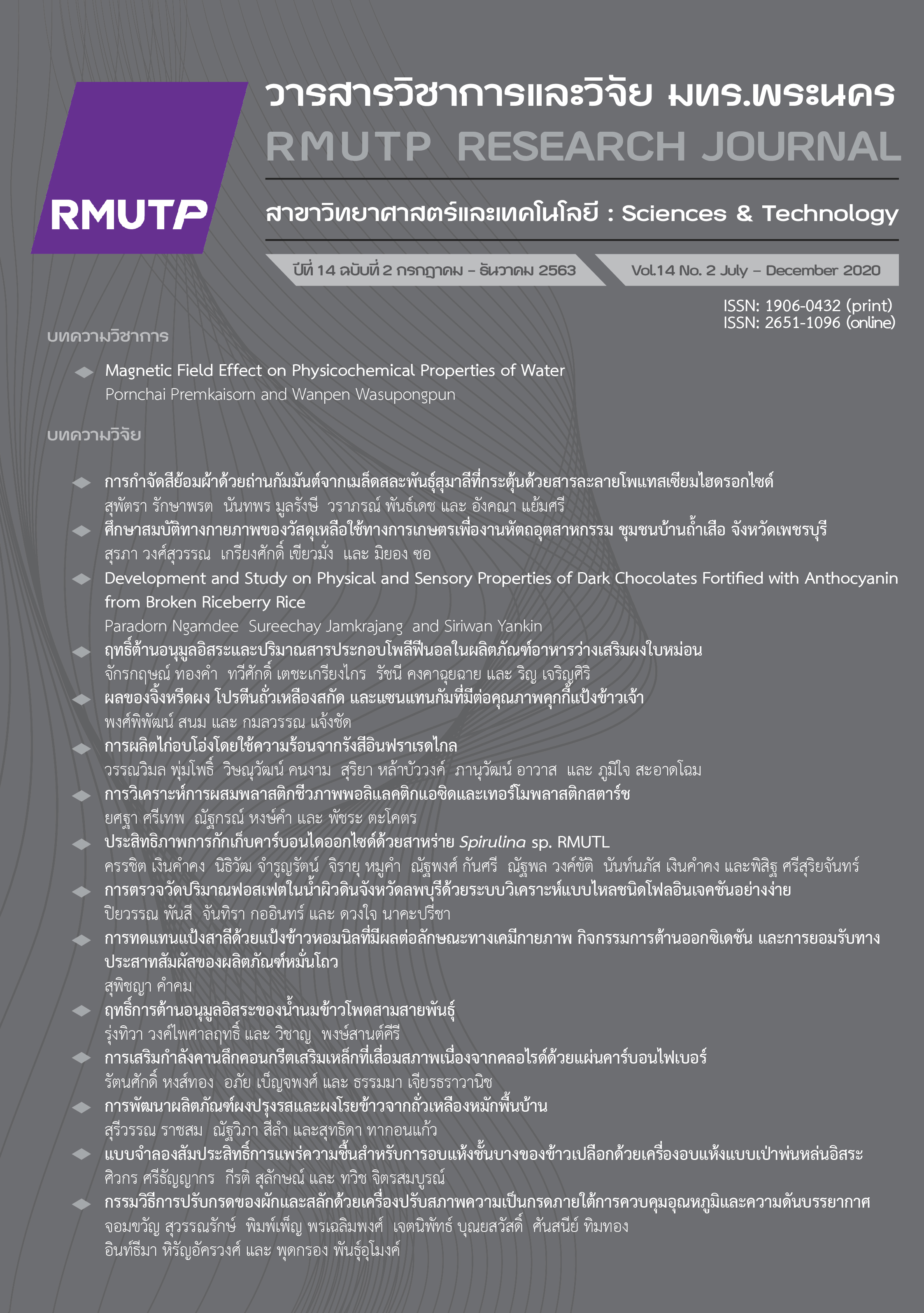การกำจัดสีย้อมผ้าด้วยถ่านกัมมันต์จากเมล็ดสละพันธุ์สุมาลีที่กระตุ้นด้วยสารละลายโพแทสเซียมไฮดรอกไซด์
Main Article Content
บทคัดย่อ
สีย้อมที่ปนเปื้อนในแหล่งน้ำ ส่งผลเสียต่อสิ่งแวดล้อมและสุขภาพของมนุษย์ คณะผู้วิจัยจึงสนใจนำเมล็ดสละพันธุ์สุมาลีเหลือทิ้งมาเตรียมเป็นถ่านกัมมันต์โดยวิธีการกระตุ้นด้วยสารละลายโพแทสเซียมไฮดรอกไซด์ความเข้มข้น 36 มิลลิโมลต่อกรัม อัตราส่วนของสารกระตุ้นต่อถ่าน 20:32 มิลลิลิตรต่อกรัม เพื่อนำไปใช้ในการดูดซับสารสีย้อม โดยศึกษาปัจจัยที่มีผลต่อการดูดซับสีย้อมในน้ำเสียสังเคราะห์ด้วยถ่านกัมมันต์จากเมล็ดสละพันธุ์สุมาลี ได้แก่ ความเข้มข้นเริ่มต้นของสีย้อม อัตราส่วนถ่านกัมมันต์ต่อสีย้อม และเวลาในการดูดซับ และตรวจสอบลักษณะสมบัติของถ่านกัมมันต์ ได้แก่ ปริมาณความชื้น การดูดซับไอโอดีน การดูดซับเมทิลีนบลู และศึกษาหาหมู่ฟังก์ชันด้วยเทคนิคฟูเรียร์ทรานส-ฟอร์มอินฟราเรดสเปกโทรโฟโตมิเตอร์ รวมถึงการศึกษาจลนพลศาสตร์ของการดูดซับ จากการทดลอง พบว่าถ่าน กัมมันต์ที่เตรียมได้มีรูพรุนขนาดเล็ก สามารถดูดซับสีย้อมในน้ำเสียสังเคราะห์สูงสุด 7.50 ± 0.25 มิลลิกรัมต่อกรัม และเข้าสู่สมดุลที่เวลา 150 นาที โดยใช้อัตราส่วนถ่านกัมมันต์ต่อสีย้อม 1:500 กรัมต่อมิลลิลิตร ที่ความเข้มข้นเริ่มต้น 200 มิลลิกรัมต่อลิตร และพบว่าอัตราเร็วการดูดซับสีย้อมสอดคล้องกับปฏิกิริยาอันดับสองเทียม (R2 = 0.9999) เมื่อเพิ่มความเข้มข้นเริ่มต้นของสีย้อม ประสิทธิภาพในการกำจัดสีย้อมก็เพิ่มตามไปด้วย แต่ถ้าเพิ่มปริมาณถ่านกัมมันต์มากขึ้น ประสิทธิภาพในการดูดซับสีย้อมจะลดลงส่งผลให้เวลาที่เข้าสู่สมดุลการดูดซับช้าลงตามไปด้วย
Article Details
References
K. Sreepongpan, Water Pollution, 3rd ed., Nahkon Pathom: Silpakorn University, 2004.
C. Park, M. Lee, B. Lee, S. W. Kim, H. A. Chase, J. Lee and S. Kim, “Biodegradation and biosorption for decolorization of synthetic dyes by Funalia trogii,” Biochemical Engineering Journal, vol. 36, pp. 59-65, 2007.
S. Wang, “A comparative study of Fenton and Fenton-like reaction kinetics in decolourisation of wastewater,” Dyes and Pigments, vol. 76, pp. 714-720, 2008.
S. Prangsiri, “Comparison of dye adsorption efficiencies by activated carbon and digested sludge from activated sludge wastewater treatment,” M.D. Thesis, Dept. Envi. Eng., Chulalongkorn Univ., Bangkok, Thailand, 2008.
C. Wanida, “Color removal technology in industrial wastewater,” Burapha Science Journal, vol. 17, no. 1, pp. 181-191, 2012.
H. M. Virginia and B. P. Adrián, Lignocellulosic precursors used in the synthesis of activated carbon: Characterization techniques and applications in the wastewater treatment, Croatia: InTech., 2012.
R. Supattra, S. Ruengwit, K. Artit, S. Surachok, P. Jatupong, S. Chadaporn and S. Monthira, “Preparation of activated carbon from Salak seed by chemical activation,” in Proceeding of GPE-6th International Congress on Green Process Engineering, Toulouse, France, 2018.
J. Guo and A. C. Lua, “Kinetic study on pyrolysis process of oil-palm stone using two-step consecutive reaction model,” Biomass and Bioenergy, vol. 20, pp. 223-233, 2001.
S. Timur, I. Cem Kantarli, E. Ikizoglu and J. Yanik, “Preaparation of a carbons from Oreganum stalks by chemical activation,” Energy and Fuels, vol. 20, no. 6, pp. 2636-2641, 2006.
S. Wirungrong, “Adsorption of methyl red dye by activated carbon from egg shell and ark shell by chemical activation method,” Science and Technology Nakhon Sawan Rajabhat University Journal, vol. 7, no. 7, pp. 97-110, 2015.
R. Supattra, M. Nuntaporn, S. Wiparat and P. Jatupong, “Preparation of activated carbon from Salak seeds for dye removal,” in Proceeding of The Pure and Applied Chemistry International Conference 2018 (PACCON 2018) “Chemistry toward a Sustainable Future”, The 60th Anniversary of His Majesty the King’s Accession to the Throne International Convention Center, Hat Yai, Songkhla, Thailand, 2018, pp. EE50–53.
H. Laksaci, A. Khelifi, M. Trari and A. Addoun, “Synthesis and characterization of microporous activated carbon from coffee grounds using potassium hydroxides,” Journal of Cleaner Production, vol. 147, pp. 254-262, 2017.
Krutoyja. (2017). Seed. [Online]. Available: https://km.nssc.ac.th/external_newsblog.php?language=Th&usid=&links=280
Thai Industrial Standard: Activated carbon, TIS900-2547. Government Gazette, 121 (79d), 30 Sep 2004.
E. F. Jaguaribe, L. L. Medeiros, M. C. S. Barreto and L. P. Araujo, “The performance of activated carbons from sugarcane bagasse, babassu, and coconut shells in removing residual chlorine,” Brazilian Journal of Chemical Engineering, vol. 22, no. 1, pp. 41-47, 2005.
Q. S. Lui, T. Zheng, P. Wang and L. Guo, “Preparation and characterization of activated carbon from bamboo by microwave-induced phosphoric acid activation,” Industrial Crops and Products, vol. 31, pp. 233-238, 2010.
S. Rawinipa, “Dyes treatment in wastewater using adsorption processes,” KKU Science Journal, vol. 44, no. 3, pp. 419-434, 2016.
D. Kavitha and C. Namasivayam, “Experimental and kinetic studies on methylene blue adsorption by Coir Pith carbon,” Bioresource Technology, vol. 98, pp. 14-21, 2007.
K. Pongsak, “Decoloraization of dyeing wastewater using regenerable catalyst,” M.D. Thesis, Dept. Chem. Eng., Songkla Univ., Songkla, Thailand, 2012.
E. Lorence-Grabowska and G. Z. Gryglewicz, “Adsorption characteristics of congo red on coal-based mesoporous activated carbon,” Dyes and Pigments, vol. 74, pp. 34-40, 2007.
U. Chakkrit, K. Thitaporn, T. Nuntakarn, K. Suchittra, P. Itthisak, S. Thai and S. Puthaporn, “Adsorption of reactive black 5 dye on activated carbon prepared from Water Hyacinth,” Journal of Science and Technology, Ubon Ratchathani University, vol. 19, no. 1, pp. 163-177, 2017.

